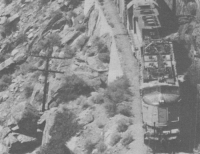|
Regenerative braking, little
understood in 1915 exce pt
by electrical engineers, is a technique which simplified and increased the
safety of mountain operation, reduced wear on brake shoes and actually
recovered electrical power and returned it to the overhead system for use
by other trains. pt
by electrical engineers, is a technique which simplified and increased the
safety of mountain operation, reduced wear on brake shoes and actually
recovered electrical power and returned it to the overhead system for use
by other trains.
The Milwaukee has long been
proud of this feature. The Milwaukee Road Magazine in 1916
described regenerative braking as
-
“a
process of producing electrical current within the motors of the
locomotive by converting the motors into generators, and the current thus
produced being returned to the trolley; and the force of gravity which
tends to make the train run away down grade is the power that drives the
generators, and the work thus performed operates to hold the train back.”
Once on a down grade, the
engineer throws a switch in the cab and regeneration takes over. The
desired speed is maintained by use of the line current control. The trains
are equipped with air brakes, but air is used only while switching into
regenerative braking and as a back-up system in case of emergency.
Returning current to the line
has proved an economic boon, since 40 to 60 per cent of the power used
ascending a grade can be returned while descending. With the numerous
grades in the Milwaukee’s mountain electrification, the railroad recovers
about 12 per cent of the total energy used by its electric locomotives and
returns it to the system, powering other locomotives or receiving credit
from the power suppliers.
Regenerative braking is now widely used
throughout the world and has been a feature of all other types of
Milwaukee Road electric locomotives. |
|
|
Benefits of regenerative
braking:
-Simplified, safer mountain operation
-Reduced wear on brake shoes
-Recovered electrical power
|
